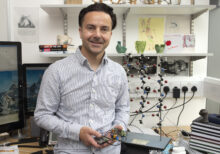
Julian Gough
Julian Gough first joined the LMB’s Structural Studies Division in 1997, as a PhD student in Cyrus Chothia’s group, working on computational and theoretical structural biology. His research in protein sequence and structure analysis of the Cupredoxin superfamily laid the foundation for the principles that led to the creation of a library of hidden Markov models (HMMs). This library of HMMs became known as the SUPERFAMILY database assigning domains of known structure to genomes. SUPERFAMILY, became widely used, forming part of the InterPro consortium. This resource laid the foundation for a decade of research by Julian and others in the field on the evolution of proteins, their domain architectures and genomes across the tree of life.
After completing his PhD in 2000, Julian worked briefly at the LMB as a postdoctoral scientist before taking up a research fellowship at Stanford University with Michael Levitt, another LMB alumnus (and Nobel Laureate). After two further positions at RIKEN in Tokyo and Institut Pasteur in Paris, he joined the faculty of the University of Bristol in 2007, subsequently becoming full professor in 2012. During these years he innovated repeatedly in the field of bioinformatics and data-driven computational biology contributing several impactful tools and resources to the field of biology spanning scales from molecules to cells and organisms. After starting his career in protein structure and sequence at the LMB, his subsequent contributions were most notably made to the fields of cell reprogramming (Mogrify) and human genetics (Nomaly).
Julian returned to the LMB in 2017 as a Programme Leader, to pursue the application of Mogrify for computationally-driven experimental cell reprogramming and to develop the application of Nomaly for predictive human genetics. Prior to joining the LMB he founded a company, now situated on the Cambridge Science Park, to apply the Mogrify cell reprogramming technology for the creation of new therapeutics. For his efforts to carry out this translation of his research in parallel to his basic science research at the LMB, he was awarded the Cambridge Enterprise 2020 Academic Entrepreneur of the Year Award. Meanwhile he and his group at the LMB recruited a genetic cohort of ~2,500 volunteers who shared their direct-to-consumer genetics data; this was used to carry out phenotype prediction using Nomaly identifying several novel biological mechanisms, and validating the use of predictive approaches in the field of genomic analysis.
Julian left the LMB in September 2023, to pursue the translation of predictive genomic analyses to disrupt the commercial use of genomic data in therapeutic development and discovery. Julian is doing this through the formation of Cambridge-based company Outsee, https://www.outsee.co.uk/.
Selected Papers
Lu, C., Zaucha, J., Gam, R., Fang, H., Smithers, B., Oates, M.E., Bernabe-Rubio, M., Williams, J., Zelenka, N., Pandurangan, A.P., Tandon, H., Shihab, H., Kalaivani, R., Sung, M., Sardar, A.J., Tzovoras, B.G., Danovi, D. and Gough, J. (2023)
Hypothesis-free phenotype prediction within a genetics-first framework.
Nature Communications 14: 919.
Rackham, O.J., Firas, J., Fang, H., Oates, M.E., Holmes, M.L., Knapp, A.S., FANTOM consortium, Suzuki, H., Nefzger, C.M., Daub, C.O., Shin, J.W., Petretto, E., Forrest, A.R.R., Hayashizaki, H., Polo, J.M. and Gough, J. (2016)
A predictive computational framework for direct reprogramming between human cell types.
Nature Genetics 48(3): 331-335.
Hunter, S., Apweiler, R., Attwood, T.K., Bairoch, A., Bateman, A., Binns, D., Bork, P., Das, U., Daugherty, L., Duquenne, L., Finn, R.D., Gough, J., Haft, D., Hulo, N., Kahn, D., Kelly, E., Laugraud, A., Letunic, I., Lonsdale, D., Lopez, R., Madera, M., Maslen, J., McAnulla, C., McDowell, J., Mistry, J., Mitchell, A., Mulder, N., Natale, D., Orengo, C., Quinn, A.F., Selengut, J.D., Sigrist, C.J.A., Thimma, M., Thomas, P.D., Valentin, F., Wilson, D., Wu, C.H. and Yeats, C. (2009)
InterPro: the integrative protein signature database.
Null Acids Res 37: D211-215.
Carninci, P., Kasukawa, T., Katayama, S., Gough, J., et al. (2005)
The transcriptional landscape of the mammalian genome.
Science 102(32): 1559-1563.
Gough, J., Karplus, K., Hughey, R., Chothia, C. (2001)
Assignment of homology to genome sequences using a library of hidden Markov models that represent all proteins of known structure.
J Mol Biol 313(4): 903-919.
